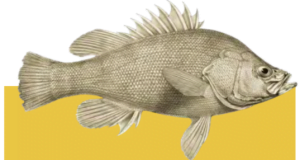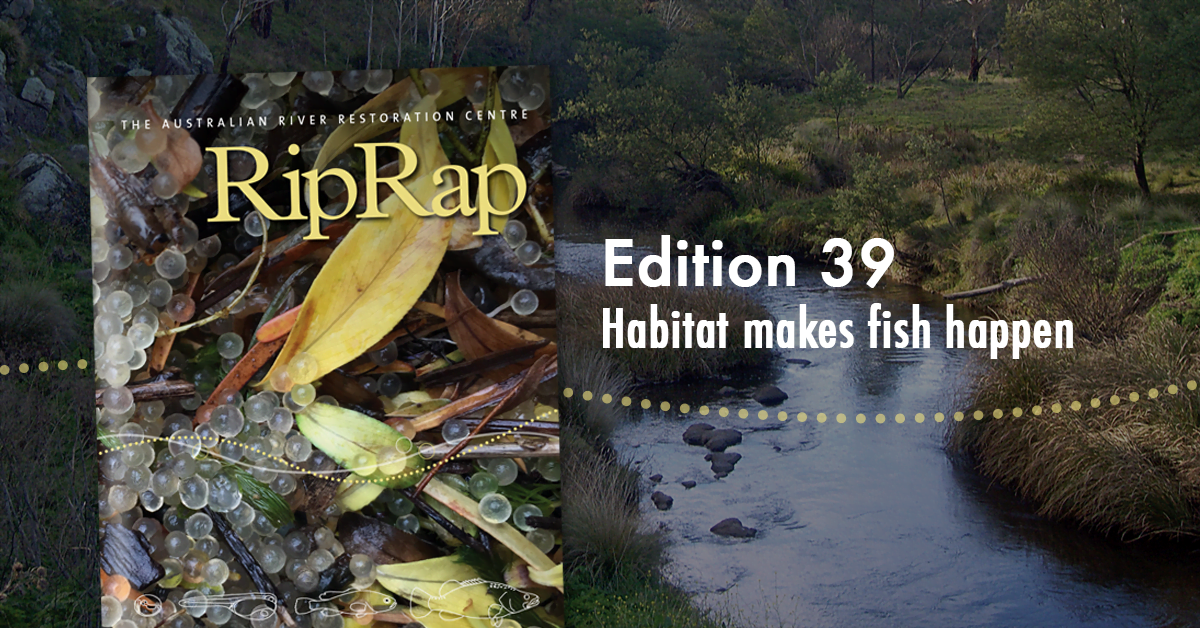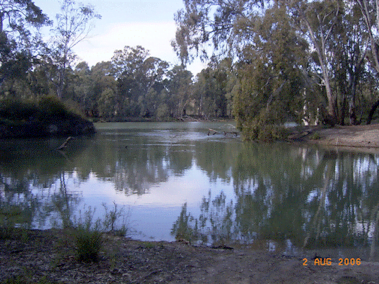There are many ways environmental water (e-water) can be used to benefit native fish either by delivering water from storages or putting rules in place that keeps water in the river as it flows downstream. E-water can:
- reconnect river, and their wetlands and floodplains, providing food, habitat and breeding opportunities for native fish,
- be sent downstream to create a new flow pulse, with he rise and fall of the water stimulating fish to move upend downstream, and into or out of wetlands,
- recreate flows that have been disrupted by river regulation, such as a winter shutdown where the tap is ‘turned off” for human water supplies and the system dries, limiting native fish survival,
- be added to other water already flowing down a river to increase river heights and connect native fish with habitats off the main channel,
- protect rivers and wetlands form extraction so that drought refuges are not pumped dry, or so that the rise and fall of a natural flow event travels further downstream
Understanding of the relationship between flow regime and the impact on the Murray-Darling Basin’s (MDB) fish is still evolving, however, scientists already know a fair bit about some aspects that fish need from water and what e-water can help provide. The snapshots on the following pages have been provided by water managers and fisheries scientists from state and Commonwealth agencies to demonstrate how e-water is benefiting native fish across the Basin.
Golden Perch – a winner!
Mid-Murray River (upstream of Barmah): The period 2013/14 saw the best spawning results for Golden perch since 2005 with good spawning results again the following year. Hattah Lakes: A release if 67 gigalitres in late 2013 and 91 gigaliter between May and September 2014 resulted in:
- observation of juvenile Golden perch,
- larval and juvenile fish in return waters into Murray River,
- Golden perch recorded moving from the lakes to the Murray at Messengers Regulator.
Murrumbidgee: Repeat Golden perch and critically endangered Silver perch spawning events were detected in 2014 along the river channel in response to the delivery of e-water.
Severn River: Six thousand megalitres was set aside for the 2015/16 season to support Murray cod and Silver perch recruitment, as well as facilitating movement, habitat access and productivity gains. Monitoring indicated good numbers of adult large-bodied native species including Golden perch and very few alien species.
Gunbower: In spring 2014 and 2015. Golden perch with acoustic tags were released into Gunbower floodplain and back into the river with the e-water event.
Goulburn River: Golden perch exhibited a strong spawning and movement response to increased flows provided by e-water, with Golden perch spawning in numbers not seen since the 2010 floods. Silver perch also spawned in association with the increased flows.
Lower Murray: Golden perch larvae were present following a pulse in late 2012. Flow-cued spawning of Golden perch and Silver perch was also found in 2013/14.


1. Warrego/Darling 2014/15
E-water decisions prolonged the inundation of key waterholes in the Warrego from natural rainfall. The Warrego then added to the mix of water coming out of the Gwydir, Condamine-Balonne, Macintyre and Barwon to stimulate food and increase habitat access in the Darling.

2. Gwydir 2014/15
E-water travelled down the Mehi River in the lower Gwydir valley to enhance in stream ecological function and provide opportunities for fish to access habitat. The event supported breeding of Carp gudgeon, Murray River rainbowfish and Bony bream.
 3. Border Rivers 2015/16
3. Border Rivers 2015/16
Six thousand megaliths was delivered to support murray cod and Silver perch recruitment in the Severn River, with good numbers of large-bodied native species found and few alien species.

4. Macquarie 2014/15
A strong spawning response in Murray cod and Freshwater catfish coincided with an e-water flow in the Macquarie.
5. Dar ling River
ling River
The lower 700 kilometres of the Darling River is a hotspot for native fish (including Golden perch, Silver perch and Murray cod), breeding good fish numbers under both natural and e-water flow events. Flows in this region are critical to protect native fish in the Basin. E-water can play a key role in protecting native fish in this reach.
 6. Lachlan 2014, 2015
6. Lachlan 2014, 2015
High rainfalls triggered a translucent dam release event in the Lachlan valley in late August 2015 ‘priming’ the system for native fish prior to their breeding period. Larval fish monitoring in the Lower Lachlan indicated that native Murray cod, Flat headed gudgeon, Eel-tailed catfish, Australian smelt and Carp gudgeon all spawned in the system.
 7. Lower Murray
7. Lower Murray
Record numbers of the endangered Murray hardyhead were captured at Berri Evaporation Basin, with a sub-population translocated to Victoria. E-water is securing a water supply to maintain these fish.
8. Ha ttah Lakes
ttah Lakes
Pumping of e-water moved juveniles of large-bodied fish into the lakes with Murray Cod, Golden perch and Silver perch taking advantage of greater lateral connectivity between the Murray channel and the floodplain.
 9. Murrumbidgee 2014
9. Murrumbidgee 2014
E-water stimulated repeat Golden perch and Silver perch spawning events. Murray cod and Australian smelt also benefited, as well as high densities of macro invertebrates that are important first feed prey of larval fish.
 10. Yanco Creek 2015
10. Yanco Creek 2015
E-water was used to reduce the extreme variability in river depths that occurs due to river operations. Nesting species such as Trout cod need family consistent water levels during spawning when tending their nests, and the water delivered in 2015 had positive outcomes for this species.
 11. Mid-Murray River
11. Mid-Murray River
E-water helped create the flow conditions favoured by Murray cod, Trout cod and Golden perch, with Murray cod in the Murray and Ovens rivers recorded at their highest levels in 14 years. Thousands (up to 2500 per day) of juvenile Silver perch moved upstream via the Torrumbarry fishway in May 2016 in response to variations in flows.
 12. Edward-Wakool River System
12. Edward-Wakool River System
Instream habitat, especially plants, has improved with e-water. This provides shelter to young or small-bodied fish like the Obscure galaxias, detected for the first time in fiver years. E-water in the Yallakool Creek created faster flowing habitat preferred by some native fish.

13. Lower Lakes
Increased lake levels resulted in Murray hardyhead and Southern pygmy perch populations surviving and demonstrating successful recruitment.
 14. Barham Lake 2015, 2016
14. Barham Lake 2015, 2016
E-water provided to Barham Lake helped remnant populations of Freshwater catfish survive and enhanced their spawning/recruitment opportunities.
1 5. Coorong
5. Coorong
E-flows in the Coorong have increased the distribution and abundance of Black bream and Small-mouthed hardyhead. With flow improving connectivity between Lake Alexandrina, the Coorong estuary and the ocean, Congolli and Common galaxias have doubled in abundance. E-water in winter has provided flows that have brought lamprey back into the River Murray. Flows in winter allow spawning migrations of lamprey with the greatest number of Pouched lamprey caught in 2015 since sampling began. These lamprey have now used fishways in the River Murray and are travelling hundreds of kilometres upstream!
 16. Gunbower 2013, 2014, 2015
16. Gunbower 2013, 2014, 2015
In 2013, e-water maintained water levels for Murray cod breeding, helping to ensure spawning and recruitment for the first time in eight years. A follow up winter are flow enabled young fish to survive and grow – previously winter shutdown in this system has reduced survival of these youngsters. E-water also helped deliver the spring 2014 and 2015 floodplain inundation. Thousands of Australian smelt and Carp gudgeon bred not he floodplain and then moved back into Gunbower Creek.

17. Barmah 2015/16
Without e-water Silver perch and Golden perch would not have spawned in 2015/15, as e-water provided the right flow triggers for spawning. One-year-old silver perch are now present in the region.
 18. Campaspe 2015
18. Campaspe 2015
Monitoring detected the presence of Murray cod and an increase in the abundance of Murray River rainbow fish which, although once widespread across the Basin, had declined in recent years in the Murray.
To read this and other great stories like it, you can purchase or download a copy of RipRap 39 magazine. A pdf version of this story is also available to download here.




